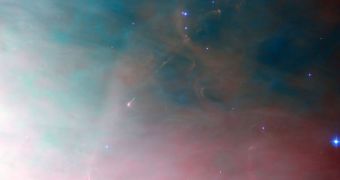A new view of the Orion Nebula taken with the NASA Hubble Space Telescope is revealing the existence of a large number of newly-forming blue stars, inside massive stellar nurseries.
These cosmic structures are in fact molecular clouds of gas and dust, which tend to come together in very large formations, under the influence of gravity and stellar winds.
Once a certain mass of gas is pulled together, and ignition process begins, that causes the hydrogen gas within the ignite, and begin a reaction of nuclear fusion. Thus, a new star is born, Space reports.
The blue fireball that develops begins to fuse hydrogen nuclei into helium, releasing a massive amount of heat and light as it does so. This makes it visible for space-based telescopes such as Hubble.
The Orion Nebula is one of the most renowned stellar nurseries in the known Universe. It has been intensively studied over the years, largely due to the fact that it's located only 1,5000 light-years away.
In the new Hubble image, the observatory managed to catch a number of newly-formed blue stars, sitting in the gas from which they formed. Hydrogen is represented by the pinkish glow in the photo.
The material that is left behind after a hydrogen clouds collapses to form a star may then develop into a protoplanetary disk, that could give birth to planets, moons, asteroids and comets, essentially seeding a new planetary system.
The narrow pink jet of gas that can be seen in the central regions of the image is called Herbig-Haro 502, and represents a type of cosmic object that regularly develops around new stars.
They are formed when blue fireballs release gas jets at speeds reaching several hundreds of kilometers per second, disturbing the material in their immediate vicinity.
But, in addition to new stars, Orion is also home to more peculiar structures. Last year, experts from the European Southern Observatory (ESO) found that the Theta 1 Orionis C system in Orion was in fact a binary star system.
The finding was made after the scientists used the Very Large Telescope Interferometer (VLTI) in Chile, which was able to distinguish that the two components of the pair were in fact orbiting each other.
The T1OC is one of the brightest star systems in the highly active Trapezium Cluster. However, it's binary nature has remained a mystery to experts for many years.
And it would stand to reason that it couldn't have been discovered until just recently. For the new research, the VLTI has behaved like a telescope with a 426-foot (130-meter) main mirror, which dwarf the capabilities of the Hubble.

 14 DAY TRIAL //
14 DAY TRIAL //